
Why Is My Dog Or Cat Azotemic?
Ron Hines DVM PhD
Azotemia Is Also Called Uremia Or Just Kidney Failure
Veterinarians will tell you that your cat or your dog is “Azotemic” when the amount of urea and creatinine in its blood are above normal. Vets and physicians measure the amount of urea in blood as BUN. It and creatinine are waste byproducts of the protein metabolism that naturally occurs in all mammals. Both compounds normally leave the body through the urine. When higher than normal in the bloodstream and when dehydration is not the cause, higher than normal levels are signs that your dog or cat’s kidneys are not functioning adequately. The more common name for that situation is uremia.
Conditions That Can Causes Azotemia In Your Dog Or Your Cat:
The most common condition that decreases the capacity of your dog or cat’s kidneys to move urea and creatinine out of its blood stream and into its urine for elimination is a reduced glomerular filtration rate= GFR. That is the rate that blood, racing through the tangle of tiny blood vessels in the many small individual filtering units (glomeruli), of your pet’s kidneys are able to produce concentrated urine. That reduction in filtering ability can be due to kidney damage (renal causes) or to a decrease in the amount of blood passing through your pet’s kidneys (pre-renal causes) such as the inefficient blood circulation that occurs when your pet has advanced heart disease, due to inadequate fluid intake or even the dehydration produced by vomiting or diarrhea. Azotemia can also be caused by any obstruction that prevents or limits your pet’s urination. In cats and in dogs that could be struvite or oxalate crystal blockages.
When BUN and Creatinine rise significantly in your dog or in your cat’s blood due to kidney disease (renal causes), veterinarians believe that about two-thirds of your pet’s kidney’s filtering units, the glomeruli, are no longer functioning. Pathologists call the kidney changes most commonly seen chronic interstitial nephritis.
Situations When Your Dog Or Cat’s Urea And Creatinine Levels Might Be Lower Than Normal
The most common causes are starvation and malnutrition. Both urea and creatinine are products of protein metabolism. So, when pets do not consume sufficient protein, their BUN and creatinine levels often drop below normal. Severe liver disease can cause a similar effect. That is because many of the food protein conversion processes normally occur in the liver. (read here)
Complementary Tests:
Complete urinalysis, including Urine specific gravity. Azotemic pets with limited remaining kidney function can compensate for a while by just producing more volumes of dilute, low SG, urine through their remaining functional kidney glomeruli. Not as much urea or creatinine leaves through each milliliter of urine, but more urine is produced. Low urine specific gravity is less diagnostic of kidney disease in cats than in dogs. Cats, by nature, are not big drinkers. Tests to check for secondary correctable problems associated with azotemia such as correctable anion gap, blood phosphorus level, blood potassium level, magnesium level, PCV to detect anemia, reticulocyte count to see if your pet’s bone marrow is responding to the anemia. After sudden trauma: imaging techniques to confirm your dog or cat’s kidney and bladder integrity. Abdominal x-rays if a urinary tract blockage is suspected.
DxMe